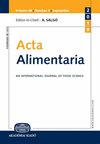低水分、粘性酱料的射频加热新方案及其温度均匀性优化
IF 1
4区 农林科学
Q4 FOOD SCIENCE & TECHNOLOGY
引用次数: 0
摘要
射频(RF)加热农业食品,特别是低水分粘性酱料(LMVS)具有明显的优势。然而,加热不均匀是射频加热技术必须解决的主要问题之一。由于加热机理不明确,被加热物体内部三维温度分布难以测量,采用计算机辅助分析方法。基于实验验证的射频加热数值计算模型和聚醚酰亚胺(PEI)辅助花生酱(PB)射频加热的特点,本研究提出了一种对现有方案的改进方法。同时,通过代理模型的多目标全局优化(MGO)对新协议的参数进行优化。结果表明,新方案中PEI块的最佳尺寸为Φ100 × 9.5 mm,位置高度为12 mm。当巴氏杀菌温度Tp为70℃,对照温度Tc为75℃时,温度均匀性评价指标超冲温度控制指数(OTCI)为0.920%,靶透入深度(TPD)为3.975 mm。与改进前的4.845%和4.940 mm相比,新方案实现了显著优化,有效提高了温度均匀性。这也在相关研究中证明了代理模型MGO方法的可行性。本文章由计算机程序翻译,如有差异,请以英文原文为准。
A new protocol for radio frequency heating of low-moisture, viscous sauces and its temperature uniformity optimisation
Radio frequency (RF) heating of agri-food, especially low moisture viscous sauces (LMVS), have obvious advantages. However, uneven heating is one main problem of RF heating technology that has to be solved. Due to the unclear heating mechanism and the difficulty to measure the three-dimensional temperature distribution in the heated object, computer-aided analysis method was adopted. Based on the RF heating numerical calculation model after experimental verification and the characteristics of polyetherimide (PEI) assisted RF heating of peanut butter (PB), this study proposed an improved method for an existing protocol. Meanwhile, parameters of the new protocol were optimised by the Multi-objective Global Optimisation (MGO) of its surrogate model. Results demonstrated that the best size of PEI block in the new protocol was Φ100 × 9.5 mm and the positional height was 12 mm. When the pasteurisation temperature Tp was set to 70 °C and the control temperature Tc was set to 75 °C, the temperature uniformity evaluation indices, Over-shoot Temperature Control Index (OTCI) and Targeted Penetration Depth (TPD), were 0.920% and 3.975 mm, respectively. Compared with 4.845% and 4.940 mm before improvement, the new protocol achieved significant optimisation and improved the temperature uniformity effectively. This also proved the feasibility of MGO method of surrogate model in relevant studies.
求助全文
通过发布文献求助,成功后即可免费获取论文全文。
去求助
来源期刊

Acta Alimentaria
农林科学-食品科技
CiteScore
1.80
自引率
0.00%
发文量
47
审稿时长
18-36 weeks
期刊介绍:
Acta Alimentaria publishes original papers and reviews on food science (physics, physical chemistry, chemistry, analysis, biology, microbiology, enzymology, engineering, instrumentation, automation and economics of foods, food production and food technology, food quality, post-harvest treatments, food safety and nutrition).
 求助内容:
求助内容: 应助结果提醒方式:
应助结果提醒方式:


